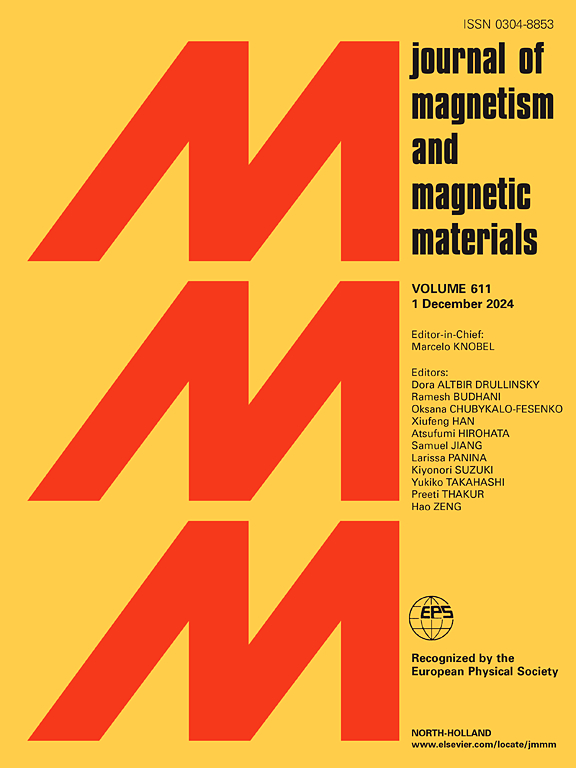A new anticrossing region of monoisotopic impurity 53Cr ions in Y2SiO5
IF 2.5
3区 材料科学
Q3 MATERIALS SCIENCE, MULTIDISCIPLINARY
引用次数: 0
Abstract
The monoisotopic impurity ions of 53Cr in a single crystal of yttrium orthosilicate (Y2SiO5) have been studied by the electron paramagnetic resonance (EPR). Several X-band EPR spin transitions of the chromium ion (S = 3/2) were recorded in magnetic fields up to 1.7 T. The chromium ion exhibited a substantial fine structure of spin sublevels, with two doublets split by 53 GHz. As a consequence of the high anisotropy of the zero-field interactions, the resonance conditions of the EPR transitions are strongly dependent on the direction of the external magnetic field relative to the crystallographic axes. In some orientations, the nonlinear dependence of the spin sublevels on the magnetic field leads to the formation of an anticrossing between spin states with projections and . In addition to this well established anticrossing region, a new region formed by the states with projections and has been identified. It appears near the upper limit of the EPR spectrometer (1.7 T), where the core of the spectrometer magnet approaches saturation. The EPR spectra of the scandium endofullerene Sc2@C80(CH2Ph) are taken as a standard to calibrate the magnetic field in this regime. This procedure enables a more accurate determination of the fine structure of the chromium ion. The values D = 25.07 GHz and E = 5.29 GHz are derived by comparing calibrated experimental data with numerical simulations.
Y2SiO5中单同位素杂质53Cr离子的新反交区
用电子顺磁共振(EPR)研究了正硅酸钇(Y2SiO5)单晶中53Cr的单同位素杂质离子。在高达1.7 t的磁场中记录了铬离子(S = 3/2)的几个x波段EPR自旋跃迁,铬离子表现出相当精细的自旋亚能级结构,两个重态在53 GHz处分裂。由于零场相互作用的高各向异性,EPR跃迁的共振条件强烈依赖于相对于结晶轴的外部磁场方向。在某些方向上,自旋亚能级对磁场的非线性依赖导致自旋态之间形成反交,其投影mS=+1/2和mS=-3/2。除了这个已建立的反交叉区域外,还确定了一个由投影mS=-1/2和mS=-3/2的状态形成的新区域。它出现在EPR光谱仪的上限附近(1.7 T),在那里,光谱仪磁体的核心接近饱和。以内富勒烯钪Sc2@C80(CH2Ph)的EPR谱为标准来标定该区域的磁场。该方法可以更准确地测定铬离子的精细结构。将标定实验数据与数值模拟数据进行比较,得到了D = 25.07 GHz和E = 5.29 GHz的值。
本文章由计算机程序翻译,如有差异,请以英文原文为准。
求助全文
约1分钟内获得全文
求助全文
来源期刊

Journal of Magnetism and Magnetic Materials
物理-材料科学:综合
CiteScore
5.30
自引率
11.10%
发文量
1149
审稿时长
59 days
期刊介绍:
The Journal of Magnetism and Magnetic Materials provides an important forum for the disclosure and discussion of original contributions covering the whole spectrum of topics, from basic magnetism to the technology and applications of magnetic materials. The journal encourages greater interaction between the basic and applied sub-disciplines of magnetism with comprehensive review articles, in addition to full-length contributions. In addition, other categories of contributions are welcome, including Critical Focused issues, Current Perspectives and Outreach to the General Public.
Main Categories:
Full-length articles:
Technically original research documents that report results of value to the communities that comprise the journal audience. The link between chemical, structural and microstructural properties on the one hand and magnetic properties on the other hand are encouraged.
In addition to general topics covering all areas of magnetism and magnetic materials, the full-length articles also include three sub-sections, focusing on Nanomagnetism, Spintronics and Applications.
The sub-section on Nanomagnetism contains articles on magnetic nanoparticles, nanowires, thin films, 2D materials and other nanoscale magnetic materials and their applications.
The sub-section on Spintronics contains articles on magnetoresistance, magnetoimpedance, magneto-optical phenomena, Micro-Electro-Mechanical Systems (MEMS), and other topics related to spin current control and magneto-transport phenomena. The sub-section on Applications display papers that focus on applications of magnetic materials. The applications need to show a connection to magnetism.
Review articles:
Review articles organize, clarify, and summarize existing major works in the areas covered by the Journal and provide comprehensive citations to the full spectrum of relevant literature.
 求助内容:
求助内容: 应助结果提醒方式:
应助结果提醒方式:


